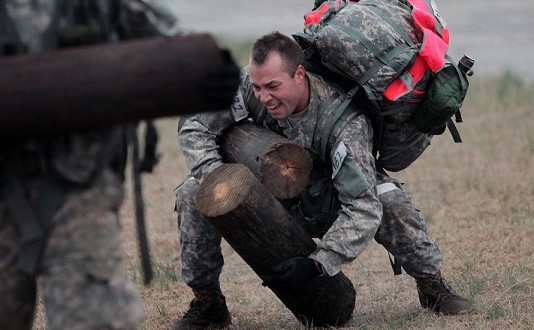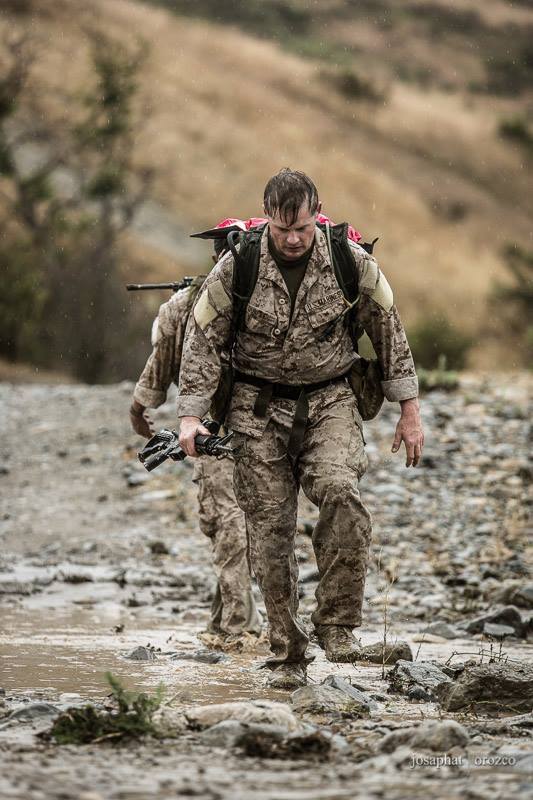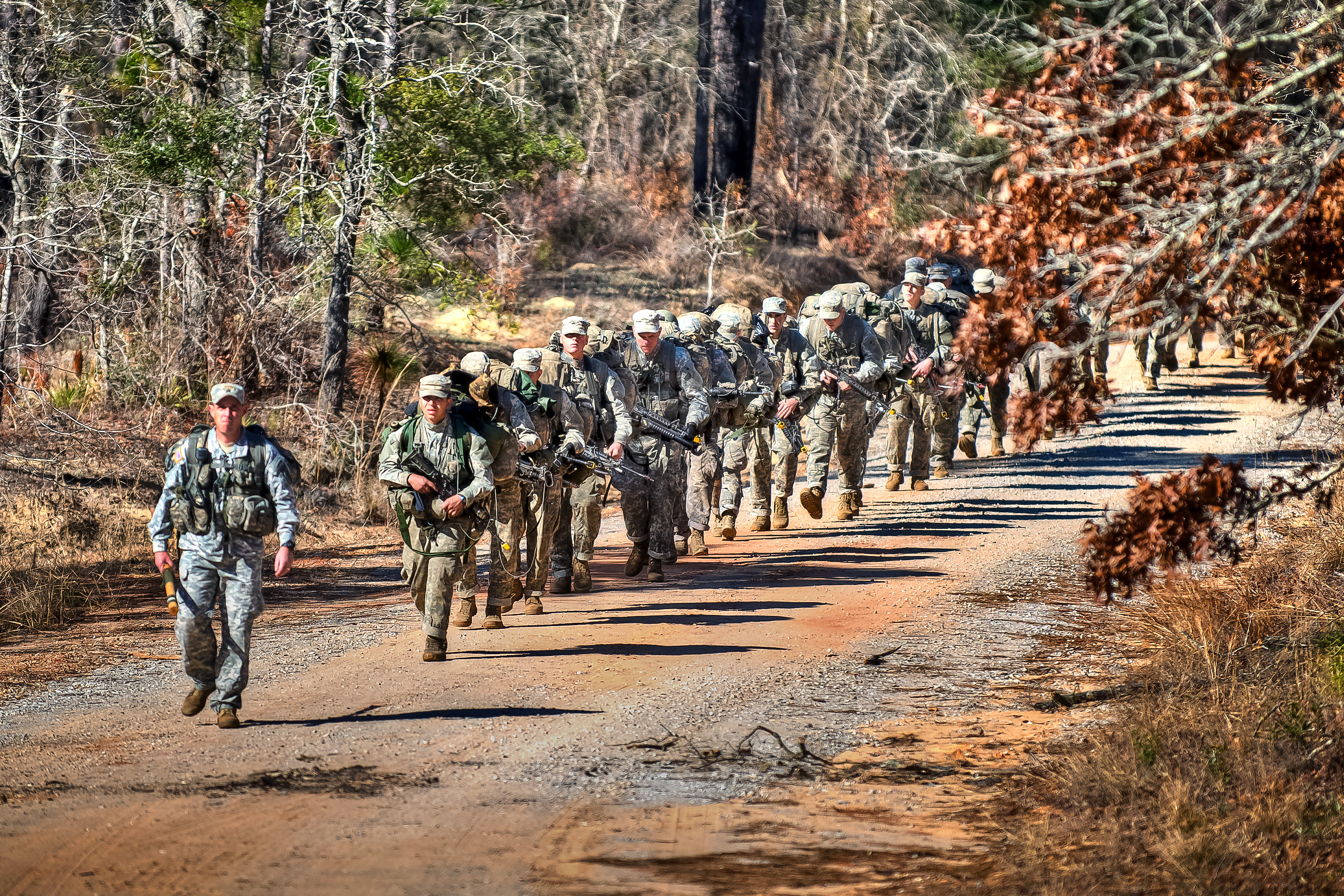| Elite & Special Forces Main Page | German Elite & Special Forces Main Page |
PART ONE: BACKGROUND
1.0 Introduction
 This article provides an overview of the German Army’s Special Forces Command or Kommando Spezialkräfte (KSK) selection and training process.
This article provides an overview of the German Army’s Special Forces Command or Kommando Spezialkräfte (KSK) selection and training process.
Established with the aid of the British SAS, the selection process for entry to KSK is extremely tough, and in one selection process “only nine out of 350 applicants passed” the course (The Local, 2008).
Candidates can apply from any Arm or Service of the Bundeswehr, as well as civilians with no prior military experience. After an administrative check, the first physical hurdle for candidates is a visit to a recruitment centre to be assessed in the specific selection criteria for the KSK.
Non-commissioned officer (NCO) candidates then join the Command Sergeant programme where they receive training and other preparation for a career with the KSK. NCO candidates will receive general training, special operations basic training, and a military parachute course and attend relevant career training and courses. Towards the end of this training candidates will undertake the three month aptitude test (Eignungsfeststellungsverfahren), successful completion of which will see the candidate transferred to the KSK to start approximately two/three years of further KSK-specific training.
From boot camp to fully operational, a candidate may undertake six years of training.
Part One of this article looks at women and the KSK, then discusses the difference between tier 1 and tier 2 forces and highlights the general duties of SOF. Part Two looks at the entry standards and applications for KSK. Part Three provides an outline of the selection and training process. Finally, Part Four provides some useful links and identifies other articles the reader may find useful.
I apologise if any of the translations are incorrect/imprecise.
1.1 Aim
The aim of this article is to describe the fundamental entry requirements, selection process and training for personnel seeking to become a member of the German Army’s Special Forces Command.
The article details the selection and training process for Operator aspirants who will fulfil roles in the operational forces, not Supporters or Enablers who fulfil roles in the support forces.
1.2 Women and the Kommando Spezialkräfte
“The German military opened all units to women in 2001, and the KSK has also committed to recruit female elite soldiers, but so far only one woman has applied, and she failed the requirements.” (The Local, 2008). As of 2015, no women had passed the KSK selection process.
1.3 Tier 1 or Tier 2 Status
The Kommando Spezialkräfte has a mixture of Tier 1 and Tier 2 units. A ‘Tier 1’ SF unit is usually tasked with direct action. Other special operations forces are referred to as ‘Tier 2’ units as they, usually, fulfil a supporting role for the Tier 1 units.
1.4 General Duties of Special Operations Forces
SOF personnel are required to infiltrate and exfiltrate to and from operational areas dismounted, carrying heavy loads and manipulating personal and support weapons systems and other heavy equipment. SOF personnel perform insertions and assaults on targets by:
- Parachuting onto ground or into water;
- Climbing ladders and cliffs;
- Rappelling;
- Conducting close-quarters battle (CQB); and
- Battle drills in varying types of terrain and climatic conditions day or night.
SOF personnel are also required to board ocean vessels while they are underway from another floating or airborne platform in all sea states day or night, and where speed and stealth are imperative. These duties are performed while wearing heavy rucksack and body armour. SOF personnel perform individual CQB and detainee handling which may require the individual to:
- Combat and detain another person using blocking strikes;
- Disarming;
- Lifting;
- Pulling;
- Ground fighting;
- Grappling; and
- Moving a non-compliant person.
There is no tolerance for a lapse in attention when conducting CQB and other assaults while wearing night vision goggles as well as Special Operations Insertion and Extraction (SOIE) techniques. Accurate discrimination of non-combatants and precision engagement of enemy combatants requires extreme concentration.
Similarly, high-risk roped and un-roped insertions with no redundant safety systems require constant attention. SOF personnel require the ability for continuous analysis of the situation, environment, mission aims and unique foreign societal complexities during operations.
PART TWO: ENTRY STANDARDS AND APPLICATIONS
2.0 Introduction
 The Bundeswehr does accept direct entry applicants, i.e. civilians with no prior military experience, for the KSK. As a result, volunteers for the KSK may be accepted from both civilians and Bundeswehr military personnel (both officer and enlisted) from any branch of military service to serve with the KSK.
The Bundeswehr does accept direct entry applicants, i.e. civilians with no prior military experience, for the KSK. As a result, volunteers for the KSK may be accepted from both civilians and Bundeswehr military personnel (both officer and enlisted) from any branch of military service to serve with the KSK.
Consequently, there are three recognised pathways to become a member of the KSK:
- Join as a Special Operations Supporter/Enabler;
- Join as a Special Forces Operator (in-service transfer from any branch of military service); or
- Join as a Special Forces Operator (as a civilian with no prior military service).
2.1 Recruitment Centres
There are currently four recruitment centres located in:
- Berlin (Recruitment Centre East);
- Munich (Recruitment Centre South);
- Dusseldorf (Recruitment Centre West); and
- Hannover (Recruitment Centre North).
2.2 General Requirements and Eligibility for All Candidates
Subject to the requirements outlined below, all Bundeswehr officers and enlisted (other ranks) personnel are eligible to attend the KSK aptitude/selection programme, known as EFV.
General Requirements for all candidates:
- They are German or German within the meaning of Article 116 of the Basic Law;
- No criminal convictions;
- Obtain approval from chain of command;
- Pass appropriate medical examination;
- Personnel file; and
- Be parachute-trained or willing to undertake parachute training.
2.3 General Requirements and Eligibility for Team Soldiers & Civilians
Recruitment criteria for Command Sergeant aspirants/candidates (Bundeswehr, 2012a):
- Age:
- Over 17 years of age and under 25 years of age;
- Education:
- Have a high-school diploma (or its equivalent education); or
- Have a secondary school education (or have a recognised equivalent level of education) and have completed vocational training.
- Period of Service:
- Willing to commit to a service period of 12 years.
2.4 General Requirements and Eligibility for Active Soldiers
Recruitment criteria for Active Soldier candidates:
- Officer candidates: under 30 years of age;
- Sergeant candidates: under 32 years of age; and
- NCO candidates: under 28 years of age.
PART THREE: OUTLINE OF SELECTION AND TRAINING
3.0 Introduction
Prior to the aptitude test, a candidate will receive several months of Army standardised and career training in order to provide them with the foundational attitude, skills and knowledge required of a special operations soldier; it will also aid preparation for the rigours of the aptitude test.
The purpose of the selection process (auswahlverfahren), or aptitude test (Eignungsfeststellungsverfahren), is to assess a candidate’s character, and mental and physical suitability for a career in the KSK.
After successfully completion of the aptitude test, candidates will then undertake further training, lasting up to 3 years, at a variety of training centres within Germany and internationally.
3.1 KSK Selection Process
The selection process (auswahlverfahren), or aptitude test (Eignungsfeststellungsverfahren), for the KSK consists of two distinct phases/parts (Bundeswehr, 2012a & 2012b):
- Phase 1: Eignungsfeststellungsverfahren Teil I (EFV I) consists of psychological tests and a physical fitness test (PFT).
- Phase 1a: Between EFV1 and EFV2, KSK delivers a 10 week programme (mainly of runs and marches) that enables candidates who have passed EFV 1 to train for EFV 2; the idead being that candidates can better prepare than in their units.
- Phase 2: Eignungsfeststellungsverfahren Teil II (EFV II) consists of a multi-day exercise.
The whole selection process lasts three months and there are usually two each year. The overarching purpose of the selection process is to ensure that only candidates who demonstrate the physical, mental and temperamentally for service as a Special Forces soldier are selected for further training. With this in mind, during the selection process, assessors are looking at five key elements:
- Basic fitness;
- Mental resilience (or toughness);
- Willing to undertake parachute training;
- Teamwork;
- Ability to learn.
 During Phase 1 (EFV I), which lasts 1 week, candidates are assessed through:
During Phase 1 (EFV I), which lasts 1 week, candidates are assessed through:
- Demonstrating teamwork through role plays.
- Psychological testing:
- Interviews (with psychologist).
- Computer-based tests.
- A sports test, which consists of:
- 5 heaves.
- A Physical Fitness Test (PFT) consisting of 5 sub-test, each providing up to 6 points (for a maximum of 30 points). Candidates must achieve a minimum of 3 points per test:
- Shuttle run (4 times 9 metres);
- Sit-ups;
- Standing long jump;
- Press-ups; and
- Twelve minutes running.
- Obstacle course to be completed in a maximum of 1 minute 40 seconds, wearing combat clothing and helmet).
- 7 kilometre Loaded March, wearing battle dress and carrying 20kg, in a maximum of 52 minutes.
- 500 metre swim to be completed in 15 minutes or less.
- A jump from a 12 metre tower to demonstrate willingness for parachute training.
The aim of Phase 1 (EFV I) is to test a candidates suitability for the training programme and their future employment as a Special Forces soldier and, in particular, for participation in Phase 2 (EFV II) of the selection process.
On average, only one in three candidates will pass EFV I, one-third failing the physical testing and two-thirds the psychological testing.
During Phase 2 (EFV II), candidates undertake a rigorous and physically demanding multi-day ‘strikethrough’ exercise which is underpinned by sleep deprivation, food deprivation, marches, carrying heavy equipment and teamwork exercises. One element of EFV II includes a gruelling 90 hour cross country march through the Black Forest. Candidates may carry up to 60 kg of equipment during EFV II but should expect to carry 40 kg as standard. As a team, candidates may also be expected to carry simulated casualties or equipment (20 kg boxes/logs) over long distances. Solo, candidates can expect to carry 20 kg logs plus their 40 kg of equipment over long distances.
If a candidate fails the aptitude test, they may gain employment as an Infantry Sergeant within a special operations unit (typically as a paratrooper Sergeant in the Airborne Brigade (Luftlandebrigade)).
3.2 KSK Training Outline
Table 1 provides an outline of the KSK training programme for Command Sergeant Candidates.
| Table 1: Outline of KSK training programme | ||
| Month | Element/Course | Description |
| 1 to 6 | Army Standardised Training |
|
| 7 | Sergeant Candidate Course |
|
| 10 | Troops Internship |
|
| 13 | Sergeant Course Module 1 |
|
| 16 | Sergeant Course Module 2 |
|
| 19 | Language Training |
|
| 22 | Sergeant Course Module 3 |
|
| 25 | Aptitude Test |
|
| 28 | Special Forces Training |
|
| Source: Bundeswehr, 2012a & 2016 | ||
 Once a candidate passes the aptitude test and is assigned to the KSK they will undertake a variety of training, based partly on their specialisation, and may include:
Once a candidate passes the aptitude test and is assigned to the KSK they will undertake a variety of training, based partly on their specialisation, and may include:
- Breach training;
- Weapons handling;
- Rappelling from helicopters;
- Close quarter battle (CQB) training;
- Hand-to-hand combat training;
- Counter-terrorism training;
- Medical training;
- Explosives training;
- Telecommunications training;
- Jungle training;
- Cold weather training;
- Mountain training; and/or
- Amphibious training.
The specialisation a candidate may obtain includes:
- Pioneer;
- Weapons;
- Medical; or
- Telecommunications.
Successful candidates sign on for six years minimum service, and wear a maroon beret with a metal badge consisting of a sword surrounded by oak leaves, with the colours of Germany on the bottom.
PART FOUR: TRAINING ORGANISATIONS
4.0 Introduction
This section of the article provides an outline of the various stakeholders who have some input to the selection and training process for the German Army’s Special Forces.
4.1 German Army Training Command
The Army Training Command, headquartered in Leipzig, has overall responsibility for Army training, translating the targets and standards set by the German Army Headquarters into policy documents concerning:
- Troop training;
- Course-based individual training;
- Joint training in the Army; and;
- Training cooperation/support/assistance.
The Command is led by a Major General (OF-7) and assisted by a Chief of Staff in the rank of Brigadier General (OF-6), who is also the Deputy Commander.
4.2 Force Development Group
The Force Development Group is one of four elements of the Kommando Spezialkräfte. The role of the Force Development Group (Bereich Weiterentwicklung) includes the development, procurement and introduction of material for the KSK:
- Development of specific operating procedures and regulations (aka Tactics, Techniques and Procedures, TTPs);
- The assessment of special weapons, vehicles and equipment; and
- The procurement of special weapons, vehicles and equipment.
4.3 Special Operations Training and Development Centre
 In 1979, the International Long Range Reconnaissance Patrol School (ILRRPS) was established in Weingarten, Germany (Johnson, 2009). In April 1997 the Kommando Spezialkräfte was activated and in August 1997 the ILRRPS moved to Pfullendorf, Germany (Johnson, 2009), becoming a school of the Special Operations Training Centre.
In 1979, the International Long Range Reconnaissance Patrol School (ILRRPS) was established in Weingarten, Germany (Johnson, 2009). In April 1997 the Kommando Spezialkräfte was activated and in August 1997 the ILRRPS moved to Pfullendorf, Germany (Johnson, 2009), becoming a school of the Special Operations Training Centre.
In May 2001 the ILRRPS was renamed the International Special Training Centre (ISTC) (Johnson, 2009).
In 2015, the Special Operations Training Centre (Ausbildungsu. Versuchszentrum or AVZ) was renamed the Special Operations Training and Development Centre (Volk, 2013).
As part of the Reorganisation of the German Army, the Special Operations Training and Development Centre is one of eleven major centres/schools of the Army Training Command (German Army, 2013). The Centre is commanded by a Colonel (Oberst) (OF-5) and is headquartered in Pfullendorf (Volk, 2013).
The centre is responsible for the initial (entry-level) and further (advanced) training of Special Forces and support personnel. The centre also delivers the aptitude/selection test (Eignungsfeststellungsverfahrens or EFV) for Special Forces aspirants.
“The training of special forces senior NCO candidates as well as special operations forces and personnel providing direct tactical support to special forces is conducted at the Specialised Operations Training Centre in Pfullendorf. Special Forces training and the support of exercises focusing on mission fulfilment in the context of national risk prevention complements the catalogue of tasks. Analogous international training is conducted at the attached International Special Training Centre.” (German Army, 2013, p.62).
4.4 Special Training Company 209
Special Training Company 209 (Spezialausbildungskompanie 209) delivers training to aspirant paratrooper and Special Forces personnel.
The Special Training Company 209 is part of the Training Group of the Special Operations Training and Development Centre.
PART FIVE: MISCELLANEOUS
5.0 Summary
The German Army’s Special Forces branch is open to all male and female commissioned and enlisted personnel of the Bundeswehr, as well as civilians. German Army Special Forces training seeks to attract determined, highly-motivated, intelligent, reliable and physically fit individuals to serve with the Kommando Spezialkräfte community. This article provides the basic information to allow individuals to make an informed judgement before applying for KSK training.
5.1 Useful Publications
- Books:
- Elite Attack Forces. German Elite Forces: 5th Mountain (Gebirgsjager) Division and the Brandenburgers (Special Forces) by Mike Sharpe and Ian Westwell, first published in 2008 by Compendium Publishing.
- German Special Forces of World War II (part of Osprey’s Elite series) by Gordon Williamson, first published in 2009 by Osprey Publishing Ltd.
- Kommando Spezialkräfte 3 – Division Spezielle Operationen (German Edition) by Heinz Duthel, first published in 2015 by Books on Demand.
- Kommando Spezial-Kräfte by Reinhard Scholzen, first published in 2009 by Motor Book.
- GSG 9 by Reinhard Scholzen and Kerstin Froese, first published in 2001 by Motorbycuhverlag.
- Research:
- Werner, L. (2013) Adaptive Reorganization of German Special Operations Forces. Master’s Thesis. Available from World Wide Web: http://www.dtic.mil/cgi-bin/GetTRDoc?AD=ADA620506. [Accessed: 25 July, 2016].
- Documents:
- Bundeswehr (2012a) Das Kommandofeldwebelanwärterprogramm. Available from World Wide Web: http://www.deutschesheer.de/resource/resource/MzEzNTM4MmUzMzMyMmUzMTM1MzMyZTM2MzEzMDMwMzAzMDMwMzAzMDY4MzU3MDYyNmQ2NzMyNzMyMDIwMjAyMDIw/Das_Kommandofeldwebelanwaertermodell.pdf. [Accessed: 27 July, 2016].
- Bundeswehr (2012b) Eignungsfeststellungsverfahrens Teil 1. Available from World Wide Web: http://www.deutschesheer.de/resource/resource/MzEzNTM4MmUzMzMyMmUzMTM1MzMyZTM2MzIzMDMwMzAzMDMwMzAzMDY4MzM2Nzc3MzE2YTYzMzIyMDIwMjAyMDIw/KSK%20Brosch%C3%BCre%20Eignungstest%20Teil%201.pdf. [Accessed: 27 July, 2016].
5.2 Useful Links
- YouTube:
- KSK:
- Bundeswehr Commando Course (Einzelkämpferlehrgang):
- Facebook:
- Documentaries:
- Special Forces Untold Stories: German GSG-9 (2002).
- Official KSK Website:
- Federal Ministry of Defence:
- German Armed Forces (Bundeswehr):
5.3 References
Bundeswehr (2012a) Das Kommandofeldwebelanwärterprogramm. Available from World Wide Web: http://www.deutschesheer.de/resource/resource/MzEzNTM4MmUzMzMyMmUzMTM1MzMyZTM2MzEzMDMwMzAzMDMwMzAzMDY4MzU3MDYyNmQ2NzMyNzMyMDIwMjAyMDIw/Das_Kommandofeldwebelanwaertermodell.pdf. [Accessed: 27 July, 2016].
Bundeswehr (2012b) Eignungsfeststellungsverfahrens Teil 1. Available from World Wide Web: http://www.deutschesheer.de/resource/resource/MzEzNTM4MmUzMzMyMmUzMTM1MzMyZTM2MzIzMDMwMzAzMDMwMzAzMDY4MzM2Nzc3MzE2YTYzMzIyMDIwMjAyMDIw/KSK%20Brosch%C3%BCre%20Eignungstest%20Teil%201.pdf. [Accessed: 27 July, 2016].
German Army (2013) The Reorientation of the German Army. Second Updated Edition. Strausberg: German Army. Available from World Wide Web: http://www.deutschesheer.de/portal/a/heer/!ut/p/c4/04_SB8K8xLLM9MSSzPy8xBz9CP3I5EyrpHK9jNTUIr3c0pySzNzUlMxEvZT88ryc_MSUYv2CbEdFAF0-8l8!/. [Accessed: 18 July, 2016].
German Army (2016) Spezialausbildungskompanie 209. Available from World Wide Web: http://www.deutschesheer.de/portal/a/heer/!ut/p/c4/NYzBCsIwEET_aJOCBevN0ot6E0TrLW2WdLHdlM1WQfx4G8EZmIF5MOZuVrN7UnBKkd1obqbtade9YEAU8IScNCm4JXUPH3-NxEL9oAsH5Ly8U4QwEnoJ5pofPUIfGTWnIiutGcRpFJij6JjJIrISIG9aWzS1Le1fxac6bqvTZWPL5lCfzTxN-y_C2sdA/. [Accessed: 30 July, 2016].
Johnson, J. (2009) International Special Training Center and NATO Celebrate 30 Years of Teaching Special Forces. Available from World Wide Web: https://www.army.mil/article/23818/international-special-training-center-and-nato-celebrate-30-years-of-teaching-special-forces/. [Accessed: 28 July, 2016].
The Local (2008) German Special Forces Offer Cash to Recruits. Available from World Wide Web: http://www.thelocal.de/20080629/12773. [Accessed: 18 July, 2016].
Volk, S. (2013) Neue Soldaten und Neuer Name fuer Kasernenstandort Pfullendorf. Available from World Wide Web: http://www.suedkurier.de/region/linzgau-zollern-alb/pfullendorf/Neue-Soldaten-und-neuer-Name-fuer-Kasernenstandort-Pfullendorf;art372570,6397414. [Accessed: 28 July, 2016].



You must be logged in to post a comment.